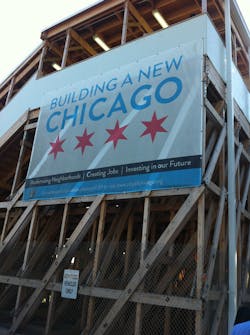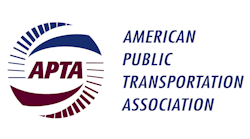With the American Public Transportation Association Annual Meeting coming to a close in Chicago, transit leaders are going back to their communities with new ideas, new perspectives and glimpses at new products to take their fleets to the next level and provide better customer service.
Despite a government shutdown and the specter of a prolonged government stalwart hindering all hope of a long-term federal transit funding deal or even providing near-term grants for new projects being completed in the near future, there hasn’t been a sense of despair hanging in the background of discussions. Instead, many seem to be inspired by the new challenges presented to them and optimistic things are about to change for the better as they prepare for a new year.
And they should be. A record number of exhibitors and registrants packed into the trade show Monday in the basement of the Hilton. New companies were there and still optimistic about dipping their toes into the transit market. I ran into Chistopher Chong with SST Wireless Inc. on two different occasions. Chong’s company makes wheel sensors for heavy-duty vehicles, which could provide a valuable data capture of transit vehicles to improve maintenance schedules and allow fleets to run better. Chong has been selling his products to mining companies and despite the challenges of breaking into the transit market at this time, he’s confident of growing his product in the market in 2014.
I met up with Jay Banasiak, director of Sun Metro in El Paso, Texas, who’s prepping to open his first bus rapid transit line in July. Two more lines are also in the process and even though the third line is being held up by the ongoing federal sequester, he’s still excited about the impact the lines will have in his city and the economic impact they will bring.
I met with organizers with Getting America to Work, which is getting more community organizations involved in transit, and they said in just the few months they’ve been in existence, moderate Republican politicians have been listening and even a few from the staunchly anti-transit conservative wing of the party are starting to come around to the value of transit and the impact it has in spurring economic growth in their communities and growing revenues for American manufacturers.
Progress in Chicago
I got a chance to tour Freedman Seating Co. on Chicago’s west side and found business is booming thanks to transit. The company is located in the original Motorola factory in an economically depressed part of town, but Freedman is providing good jobs and good wages to 600 people. Executive Vice President of Sales and Marketing Dan Cohen said they focus on hiring people in the neighborhood and work with a local high school to make sure kids in the area are getting the skills they need to set them on course of landing great manufacturing jobs. A lot of the parts going into the seats are from the Midwest, so Freedman is seeding manufacturing talent to work not only for their company, but for other manufacturers who will design and build future bus and rail components and vehicles.
Optimism was driven home further during the technical tours offered of CTA facilities and the Chicago Department of Transportation’s Divvy bike share system. "Mass Transit" publisher John Hollenhorst took the Divvy tour and mentioned how interesting the system is and the ways Chicago is working to improve bicycle traffic infrastructure in the Loop.
I took a tour of the CTA Red Line reconstruction from 95th Street into the Cermak-Chinatown station and saw how one of the busiest lines in the CTA system was shut down, taken down to dirt and rebuilt in a scant five months. In three weeks the line will reopen and customers will see travel times from the south side to downtown drop by 20 minutes. CTA officials said the success of the project has them looking into rehabilitating the Red Line to the city limits to the south and also looking to renovate the northern arm past downtown where 1920s-era infrastructure is still being used.
At the Garfield Green Line stop a vacant lot was transformed into a bus depot to shuttle Red Line passengers during construction and it will soon be turned into a park-and-ride once the Red Line is up and running again. Near the University of Chicago, but still in an economically depressed area of the city, CTA officials said it’s the hope the Garfield station — which had been pegged the main station when the city bid for the 2016 Olympics several years ago — will spur transit-oriented development in the neighborhood and prove as another example where transit will spur growth.
Across the city and along the CTA construction, banners hang reading “Building a new Chicago” and Mayor Rahm Emanuel told APTA members he’s using transit as a crucial peg to grow the local economy and bring new life to neighborhoods. And maybe the progress in Chicago inspired the optimism despite the federal political climate because the people I met all talked about economic development they’re seeing in their communities thanks to transit. And maybe they realize a new generation of workers and voters and leaders are seeing this and making transit more of a priority in their communities.





